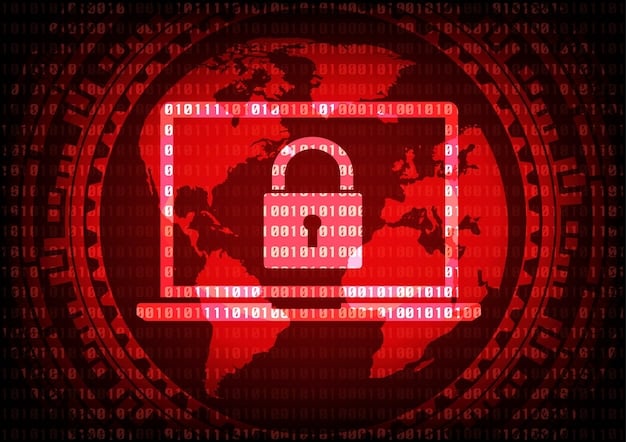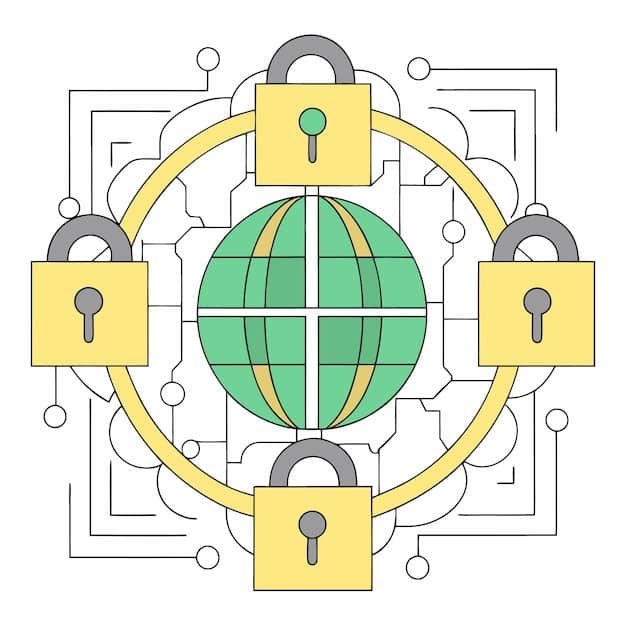Cybersecurity Threats on the Rise: Mitigate Risks, Prevent Losses

Cybersecurity threats are escalating, impacting businesses of all sizes with increasing sophistication and frequency, demanding proactive strategies and robust defenses to mitigate risks and prevent significant financial losses.
In today’s interconnected world, businesses face an ever-evolving landscape of digital dangers. Understanding how cybersecurity threats on the rise: how businesses can mitigate risks and prevent financial losses is no longer optional; it’s a critical imperative for survival and sustained growth.
The evolving landscape of cyber threats
The digital age has ushered in unprecedented opportunities for businesses, but with these advancements come lurking dangers. The sheer volume and sophistication of cyber threats are escalating at an alarming rate, transforming the cybersecurity landscape into a complex and treacherous terrain. What was once considered a minor inconvenience can now lead to crippling financial losses, reputational damage, and even operational shutdowns. It is crucial for every business, regardless of size or industry, to recognize the gravity of this situation and prepare accordingly.
Today’s attackers are not just isolated individuals; they are often well-funded, highly organized groups, sometimes even state-sponsored entities. Their motives range from financial gain through ransomware and data theft to industrial espionage and political disruption. The methods they employ are continuously refined, making traditional defenses often insufficient. From sophisticated phishing campaigns that trick employees into divulging sensitive information to advanced persistent threats (APTs) that lie dormant within networks, the sheer variety of attack vectors requires a multi-layered and adaptive defense strategy.
Phishing and social engineering: the human element
Perhaps one of the most effective and persistent cyber threats involves manipulating the human element. Phishing, spear phishing, and other social engineering tactics exploit human trust and curiosity. Attackers craft convincing emails, messages, or websites designed to trick employees into revealing credentials, clicking malicious links, or downloading infected files. These attacks often bypass technical security measures because they prey on the natural tendencies of individuals.
- Deceptive emails appearing from legitimate sources.
- Fake login pages designed to steal credentials.
- Urgent requests creating a sense of panic and urgency.
The rise of remote work has only exacerbated this vulnerability, as employees may be using less secure home networks or devices, and the lines between personal and professional digital lives can blur. Training and awareness programs are paramount to arm employees with the ability to identify and report suspicious activity, turning them into the first line of defense rather than an easy target.
Beyond phishing, other forms of social engineering, such as pretexting and baiting, involve elaborate scams designed to gain access to sensitive information or systems. Pretexting involves creating a fabricated scenario to induce a target to divulge information, while baiting uses enticing offers (like “free” software or media files) to trick users into downloading malware. Understanding these tactics is vital for any organization looking to bolster its human and technical defenses.
Ransomware: a growing financial burden
Ransomware stands out as one of the most financially crippling cyber threats currently active. This malicious software encrypts a victim’s files, rendering them inaccessible until a ransom payment, usually in cryptocurrency, is paid. The insidious nature of ransomware lies in its ability to quickly propagate across networks, disrupting operations and holding critical data hostage. Thousands of businesses, from small startups to large corporations, have fallen victim to these attacks, often facing impossible choices: pay the ransom and hope for data recovery, or rebuild systems from scratch, incurring massive costs and downtime.

The financial ramifications extend far beyond the ransom payment itself. Businesses suffer from lost productivity due to system downtime, costs associated with incident response and recovery, legal fees, and potential regulatory fines for data breaches. The reputational damage can also be severe, eroding customer trust and impacting future business prospects. Some organizations are forced to shut down entirely, unable to recover from a well-executed attack.
Proactive measures against ransomware
Mitigating the risk of ransomware requires a multi-faceted approach centered on prevention, detection, and recovery. Simply put, preventing the initial infection is ideal, but robust recovery capabilities are non-negotiable for business continuity. Implementing strong network segmentation can limit the lateral movement of ransomware if an infection occurs, containing the damage to isolated parts of the network.
- Regular, segmented, and immutable backups.
- Robust endpoint detection and response (EDR) solutions.
- Employee training on ransomware identification.
Furthermore, maintaining updated security software, patching vulnerabilities promptly, and implementing multi-factor authentication (MFA) across all systems can significantly reduce the attack surface. Many ransomware attacks exploit known vulnerabilities; therefore, a rigorous patch management program is a foundational element of defense. Investing in threat intelligence feeds can also help organizations stay ahead of emerging ransomware variants and attack techniques.
The decision to pay a ransom is complex and often controversial. While some organizations pay to regain access to their data quickly, there is no guarantee that the data will be decrypted, or that the attackers won’t demand more money. Law enforcement agencies typically advise against paying ransoms, as it fuels the criminal economy and encourages more attacks. Instead, businesses should focus on having comprehensive backup and recovery plans in place to avoid this difficult dilemma entirely.
Insider threats: risks from within
While external attacks often grab headlines, insider threats pose an equally significant, and sometimes more insidious, danger. An insider threat refers to a security risk that originates from within the targeted organization. This can involve current or former employees, contractors, or business partners who have authorized access to an organization’s systems and data, and who then misuse that access to compromise the security of the organization’s information or systems. Insider threats are particularly challenging because they bypass traditional perimeter defenses and often involve trusted individuals.
There are generally two types of insider threats: malicious and unintentional. Malicious insiders intentionally steal data, sabotage systems, or engage in espionage for personal gain, revenge, or ideological reasons. Unintentional insiders, on the other hand, pose a risk due to negligence, lack of awareness, or susceptibility to social engineering. They might accidentally click on a phishing link, misconfigure a system, or lose a device containing sensitive information.
Detecting and preventing insider threats
Detecting insider threats requires a combination of technological solutions and a strong organizational culture. Monitoring employee behavior, especially access patterns to sensitive data, can help identify anomalies. User and Entity Behavior Analytics (UEBA) tools leverage machine learning to establish a baseline of normal behavior and flag deviations that might indicate malicious activity. Data Loss Prevention (DLP) solutions can prevent sensitive information from leaving the organization’s control, whether intentionally or accidentally.
- Strict access controls and principle of least privilege.
- Regular security awareness training for all employees.
- Robust logging and monitoring of user activities.
Beyond technology, fostering a positive work environment and conducting thorough background checks for new hires are critical. A culture of accountability, where employees understand their cybersecurity responsibilities and feel comfortable reporting concerns, can also deter malicious insiders. Furthermore, implementing clear policies for data handling, remote work, and device usage helps minimize unintentional breaches.
Offboarding procedures are also crucial. When an employee leaves, swiftly revoking their access to all systems, applications, and physical premises is essential to prevent disgruntled former employees from causing harm. Regular audits of access permissions ensure that individuals only have the level of access required for their current role, reducing the potential impact of an insider threat.
Supply chain attacks: a networked vulnerability
In our increasingly interconnected ecosystem, businesses rarely operate in isolation. They rely on a complex network of vendors, suppliers, and partners, forming what is known as the supply chain. While this collaboration fosters efficiency, it also introduces a significant cybersecurity vulnerability: the supply chain attack. Unlike direct attacks, a supply chain attack targets an organization by exploiting vulnerabilities in its weaker, less secure suppliers or third-party software components. Attackers compromise a trusted third-party vendor, then use that compromised access to infiltrate the primary target. The SolarWinds attack, for instance, demonstrated how a single breach in a software provider could compromise thousands of its customers, including government agencies and major corporations.
These attacks are particularly dangerous because they leverage trust. Organizations often assume that software or services acquired from reputable vendors are secure. However, if a component of that software or service is compromised at any point in its development or delivery, the vulnerabilities can propagate throughout the entire chain, affecting every client downstream. This makes detecting and preventing such attacks incredibly challenging, as the initial breach occurs outside the primary organization’s direct control.
Securing the supply chain
Mitigating supply chain risks requires a proactive and comprehensive approach that extends beyond an organization’s own perimeter. Due diligence in vendor selection is paramount. Businesses must thoroughly vet their suppliers’ security postures, requesting detailed security assessments, certifications, and audit reports. This isn’t a one-time process; continuous monitoring and regular re-assessments are essential to ensure ongoing compliance and security.
- Conduct thorough security assessments of all third-party vendors.
- Implement strict contract clauses regarding cybersecurity requirements.
- Monitor for vulnerabilities in third-party software and components.
Implementing strong vendor risk management frameworks helps categorize suppliers based on their access to sensitive data and systems, allowing for tailored security requirements. Using secure development practices in software creation, ensuring components are sourced from trusted repositories, and employing rigorous testing for vulnerabilities throughout the software development lifecycle are also critical. Furthermore, network segmentation can help limit the damage if a third-party compromise does occur, containing the breach to isolated segments.
Organizations should also adopt a “zero-trust” approach, where no entity, inside or outside the network, is automatically trusted. Every access request is verified, and access is granted only on a least-privilege basis. This approach, combined with continuous monitoring of network traffic for anomalies that might indicate a supply chain compromise, enhances overall resilience against these sophisticated attacks. Educating employees about the risks associated with third-party software downloads and external links is also crucial.
IoT vulnerabilities: a sprawling attack surface
The proliferation of Internet of Things (IoT) devices has created an expansive and often unsecured attack surface for businesses. From smart sensors in factories and connected medical devices in healthcare to smart thermostats and security cameras in offices, IoT devices are now ubiquitous. While they offer immense benefits in terms of data collection, automation, and efficiency, many of these devices are designed with convenience in mind, often neglecting fundamental security features. This oversight makes them attractive targets for cybercriminals, who can exploit weak default passwords, unpatched vulnerabilities, and inadequate encryption to gain entry into corporate networks.
A compromised IoT device can serve as a backdoor into a company’s entire network, allowing attackers to move laterally and access more sensitive systems and data. Imagine a smart HVAC system being exploited to disrupt operations, or a networked security camera being used to spy on internal activities. The sheer number and diversity of IoT devices, often deployed without central IT oversight, complicate security efforts, making it difficult to even catalog all potential entry points, let alone secure them comprehensively.
Mitigating IoT risks
Securing the IoT landscape requires a dedicated strategy focused on asset management, network segmentation, and continuous monitoring. The first step is to identify and inventory all IoT devices connected to the corporate network. Understanding what devices are present, what data they collect, and how they communicate is fundamental to managing their risks. Many organizations aren’t even aware of the full extent of their IoT footprint.
- Inventory all IoT devices and assess their security posture.
- Isolate IoT devices on separate, segmented networks.
- Change default credentials immediately upon deployment.
Implementing strong network segmentation is crucial. IoT devices should be isolated on separate network segments, away from critical business systems and sensitive data. This reduces the risk of a compromised IoT device becoming a pivot point for a broader network infiltration. Regular patching and firmware updates are also essential, as many IoT devices remain vulnerable for extended periods due to lack of maintenance. Given the high volume of IoT deployments and the often proprietary software they run, this can be a significant operational challenge.
Furthermore, businesses must prioritize purchasing IoT devices with robust security features built-in, and implementing strong authentication mechanisms beyond simple passwords. Using device authentication, such as certificates or unique identifiers, and encrypting all data transmitted by IoT devices, significantly enhances their security posture. Continuous monitoring of IoT network traffic for unusual patterns or suspicious activity can help detect and respond to potential compromises swiftly. Ignoring IoT security is akin to leaving countless windows and doors open in a highly vulnerable digital building.
The importance of a robust incident response plan
Even the most advanced cybersecurity defenses cannot guarantee absolute protection. Breaches are an unfortunate reality, and it’s not a question of ‘if’ but ‘when’ a business will experience one. Therefore, having a comprehensive and well-tested incident response plan is critical for mitigating the damage and ensuring business continuity following a cyberattack. An effective incident response plan serves as a roadmap, guiding an organization through the chaos and uncertainty of a security breach, minimizing downtime, limiting data loss, and restoring normal operations as quickly as possible.
Without a predefined plan, businesses often react chaotically during an attack, leading to delayed containment, incomplete remediation, and potentially greater financial and reputational harm. An incident response plan outlines the roles and responsibilities of various teams, the steps for detection, analysis, containment, eradication, recovery, and post-incident review. It also includes communication strategies for informing stakeholders, customers, and regulatory bodies, which is vital for legal compliance and maintaining trust.
Developing an effective incident response plan
Creating and maintaining a robust incident response plan is an ongoing process that involves several key stages. The first step is preparation: establishing a dedicated incident response team, defining their roles, and creating clear procedures. This includes drafting communication templates, identifying key contacts (legal counsel, PR, external cybersecurity experts), and ensuring necessary tools and resources are available.
- Establish a dedicated incident response team and clear roles.
- Define clear procedures for detection, analysis, containment, and recovery.
- Regularly test the plan through drills and simulations.
Detection and analysis involve identifying a breach, understanding its scope, and determining the root cause. Containment aims to stop the spread of the attack, while eradication focuses on removing the threat entirely from systems. Recovery then involves restoring affected systems and data from backups, bringing operations back online. The final stage, post-incident review, is crucial for learning from the breach, identifying weaknesses, and improving the cybersecurity posture. This feedback loop ensures that the organization continually evolves its defenses against future threats. Regular testing of the plan, through tabletop exercises and simulated attacks, helps identify gaps and refine procedures, ensuring that the team can perform effectively under pressure. An untested plan is merely a theory; only through practice does it become a valuable tool.
Regulatory compliance and cyber insurance
The increasing frequency and severity of cyberattacks have prompted governments worldwide to introduce stringent data protection and privacy regulations. Laws like GDPR (General Data Protection Regulation) in Europe, and various state-specific laws such as CCPA (California Consumer Privacy Act) in the US, impose strict requirements on how businesses collect, process, and protect personal data. Non-compliance can result in substantial fines, legal action, and significant reputational damage. Businesses must understand not only the technical aspects of cybersecurity but also the legal and regulatory landscape they operate within, ensuring their data handling practices meet all applicable requirements. This complexity demands dedicated legal and compliance expertise.
Cyber insurance has emerged as a crucial financial safety net in this environment. While it cannot prevent an attack, it can significantly mitigate the financial fallout from a data breach or cyber incident. Cyber insurance policies are designed to cover various costs associated with a cyberattack, including forensic investigation, legal fees, notification costs for affected individuals, public relations expenses, data recovery, and even ransom payments (though the latter remains complex and often debated). It acts as a risk transfer mechanism, allowing businesses to offload some of the financial burden of increasingly sophisticated and costly cyber incidents.
Navigating compliance and insurance
Achieving and maintaining regulatory compliance requires continuous effort. Businesses must conduct regular data audits to identify what sensitive data they hold, where it is stored, and who has access to it. Implementing robust access controls, data encryption, and transparent privacy policies are fundamental. Employee training on data privacy regulations is also essential, ensuring that staff understand their responsibilities in handling protected information. Organizations should also consider appointing a Data Protection Officer (DPO) or cybersecurity compliance specialist, especially if they handle large volumes of sensitive data, to oversee adherence to regulations.
- Conduct regular data audits to ensure compliance with regulations.
- Implement strong data encryption and access controls.
- Evaluate cyber insurance policies thoroughly, understanding coverage and exclusions.
When it comes to cyber insurance, businesses need to carefully evaluate various policies and their terms. Not all policies are created equal, and coverage varies widely. It is important to understand what types of incidents are covered, what exclusions apply, and what the deductibles and limits are. Many insurers now require businesses to demonstrate a certain level of cybersecurity maturity—such as having an incident response plan, performing regular vulnerability assessments, and implementing multi-factor authentication—before offering coverage or favorable premiums. Therefore, investing in cybersecurity defenses can directly impact the affordability and availability of cyber insurance, highlighting the interconnectedness of risk mitigation strategies.
Moreover, insurers often provide resources and expertise that can be valuable during an incident, such as access to preferred incident response firms or legal counsel. This combined approach of robust internal security, adherence to regulatory mandates, and strategic cyber insurance coverage offers the most comprehensive protection against the escalating threat of cyberattacks in today’s digital economy. The intersection of these elements forms a resilient framework for business continuity in a high-risk environment.
| Key Point | Brief Description |
|---|---|
| 🛡️ Proactive Defense | Implement multi-layered security measures, including strong firewalls, antivirus, and intrusion detection systems. |
| ⚙️ Employee Training | Educate staff on identifying phishing, social engineering, and safe online practices to strengthen the human firewall. |
| ⏱️ Incident Response Plan | Develop and regularly test a clear plan for detection, containment, and recovery to minimize breach impact. |
| ☁️ Data Backups | Perform regular, isolated, and tested backups to ensure quick data recovery after ransomware or data loss incidents. |
Frequently Asked Questions about Cybersecurity
▼
Businesses commonly encounter threats like phishing, ransomware, insider threats, and supply chain attacks. Phishing targets employees with deceptive emails, while ransomware encrypts data for ransom. Insider threats originate from within, and supply chain attacks exploit vulnerabilities in third-party vendors, making a multi-faceted defense crucial for modern enterprises.
▼
Employee training is vital as it empowers staff to be the first line of defense. By educating them on identifying phishing attempts, recognizing social engineering tactics, and understanding safe computing practices, businesses can significantly reduce human-error-related breaches. Regular training ensures employees stay updated on evolving threats and company security policies.
▼
A supply chain attack targets an organization by compromising a trusted third-party vendor or software component. It’s dangerous because it exploits the trust between organizations, allowing attackers to bypass direct defenses. Once a supplier is breached, the malicious code or access can trickle down to all their customers, leading to widespread compromise.
▼
Yes, cyber insurance is increasingly necessary for SMBs. While it doesn’t prevent attacks, it helps alleviate the significant financial burden of a breach, covering costs like data recovery, legal fees, regulatory fines, and reputational damage. Given that SMBs are frequent targets, cyber insurance provides a crucial financial safety net.
▼
Upon detection, a business should immediately activate its incident response plan. Key steps include isolating affected systems to prevent further spread, conducting a thorough forensic investigation to understand the breach’s scope, eradicating the threat, and initiating data recovery from backups. Communication with stakeholders, legal counsel, and regulatory bodies also needs to commence promptly.
Conclusion
The escalating wave of cybersecurity threats presents a formidable challenge to businesses worldwide, demanding a pivot from reactive measures to proactive, multi-layered defense strategies. From sophisticated phishing schemes and financially crippling ransomware to insidious insider threats, vulnerable IoT ecosystems, and extensive supply chain compromises, the attack surface has never been broader or more complex. Successfully navigating this landscape requires not only robust technological safeguards—like advanced threat detection systems, strong access controls, and diligent patching—but also a profound commitment to continuous employee education and the development of comprehensive incident response plans. Moreover, adhering to evolving regulatory compliance and strategically leveraging cyber insurance are no longer optional add-ons but essential components of a resilient cybersecurity posture. By integrating these practices, businesses can significantly mitigate risks, protect their financial assets, safeguard their reputation, and ensure continuity in an increasingly perilous digital world.






